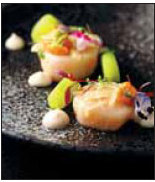Pigeon, langoustine and cheeks
Pigeon is delicate, and it takes a good chef to cook it well, especially since it can be easily overdone or undercooked. The bird is a tasty morsel, but it is hard to find good pigeon, even in the best Cantonese restaurants.
At the China World Summit Wing's Grill 79, new chef Guven Uyanik surprises with his roasted pigeon with foie gras, an unusual offering on his degustation menu.
"Timing is very important," says the Canadian chef of Turkish origin. "I personally love pigeon. I tried it for the first time at 12 years old. I have always come out with good result with it."
Some other highlights of the new chef's menu are ravioli of langoustine, duet of Australian beef, and "deconstructed" Baileys cheesecake.
These dishes look deceptively simple, but there is a great amount of effort behind each.
The duet of beef, for example, has an interesting contrast in taste. The grilled sirloin is firm, while the braised short rib is very tender. The plum juice was a recipe inspired by the chef's grandmother, and the side dish of mashed tomatoes is hand-stirred vigorously before being passed through a fine sieve.
Although the chef is just 30, he has an impressive resume, having worked with Thomas Keller at The French Laundry, the Michelin three-star restaurant in Napa Valley, the United States, where tables need to be booked four months ahead.
|
|
|
Hand dived scallop ceviche. |
Working at the French Laundry for two and a half years was interesting but challenging for Uyanik, because the menu changed daily depending on the produce available.
The chef says he learned "perfectionism, cooking techniques and management skills" with Thomas Keller.
"It was tough but good for young chefs," he says.
After that, Uyanik worked in the kitchens of Gordon Ramsay at Maze for five years, and then at Claridge's, a classic French venue in London. Maze has a Michelin one star. After that he managed the Kee Club in Hong Kong and Shanghai as the group chef.
The chef defines his style as "deformalized fine dining", and his philosophy "cooking without boundaries", where premium ingredients are top priority at all times.
By "deformalized fine dining" he means fine dining food served in a comfortable and relaxed setting.
On the other hand, quoting French Michelin-star chef Alan Ducasse, Uyanik believes "cooking is 60 percent ingredient, 40 percent technique".
"I'm a firm believer of quality produce," says the chef.
Dehydrating, caramelizing, and deconstructing - the menu will not be short of Michelin-starred tricks. But the chef prefers to retain the original taste and even shapes of ingredients. He wants to find the best ingredients in Beijing and has already sourced some good fish and poultry in Beijing, prawns, scallops, lobster and sea urchin.
"Some spices in Beijing are quite interesting," he says. These include chili oil, which goes rather well with cucumber, and Sichuan pepper, which he finds to be a good match with sea salt and fish.
Uyanik says he has never stopped learning.
His cooking style has benefited from his traveling and includes French, Italian, Turkish and some Asian influences.
"In every country I traveled, I saw different eating habits, different ingredients," he says. He thinks French and Chinese cuisine are very sophisticated in terms of technique, while Japanese and Italian cuisine impress him with great ingredients.
The chef has been in Beijing for three months and he has already drafted a new menu, which will launch in mid-November and includes all his signature dishes: lobster, foie gras and truffle.
While he believes in good plating, Uyanik says his process is simple, and does not taste for looks.
To suit diners in the winter season, the menu has a few winter soups, more hot dishes, more meats and root vegetables. His "hearty dishes" include veal cheek, "his majesty's favorite", referring to a traditional dish in Turkey served to Ottoman sultans.
"It is going to be an interesting dish," he promises.
yejun@chinadaily.com.cn


























